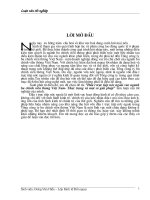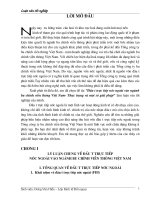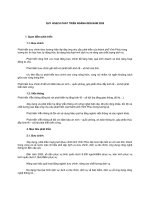Báo cáo về học hỏi đổi mới ngành bưu chính viễn thông
Bạn đang xem bản rút gọn của tài liệu. Xem và tải ngay bản đầy đủ của tài liệu tại đây (1.64 MB, 50 trang )
VEPR Working Paper
WP-16
Learning, Upgrading, and Innovation in the
Telecommunications Industry in Vietnam:
A Rent Management Analysis
Christine Ngoc Ngo
© 2014 Vietnam Centre for Economic and Policy Research
University of Economics and Business, Vietnam National University Hanoi
WP-16
Learning, Upgrading, and Innovation in the
Telecommunications Industry in Vietnam:
A Rent Management Analysis
Christine Ngoc Ngo
This paper should not be reported as representing the view of the VEPR. The views expressed in
this report are those of the author(s) and do not necessarily represent those of the VEPR.
Learning, Upgrading, and Innovation in the
Telecommunications Industry in Vietnam:
A Rent Management Analysis
Christine Ngoc Ngo
Assistant Professor
Department of Economics and Business Studies
Drew University
ABSTRACT
This paper analyzes the industrial success of the telecommunications industry in Vietnam using
developmental rent management analysis (DRMA). The empirical evidence for this study is
primarily based on 42 semi-structured interviews with government officials, firm managers,
suppliers, workers, and industry experts from 2010 to 2012. DRMA suggests that the industry’s
success was based on a number of rent management factors that corrected certain market failures
and encouraged significant effort for learning and technology adoption. These factors were
fundamentally based on: (1) favorable political supports for rent creation from the state, (2) an
effective structure of rent allocation and implementation, and (3) credible incentives and
pressures that encouraged industrial upgrading. While each factor by itself was insufficient to
ensure the success of the industry, their synthesis was such that Vietnamese telecom operators, in
particular Viettel Group, were motivated and compelled to rapidly expand their industrial
capability through technical learning and upgrading.
Paper prepared for the Annual Conference of the Allied Social Science Associations (ASSA) in
Philadelphia, PA, January 3–5, 2014. All comments are welcome and appreciated. Please do not
quote without the author’s permission.
1
TABLE OF CONTENTS
1.
Introduction ............................................................................................................................ 3
2.
Summary of the DRMA Framework .................................................................................... 6
3.
Industrial Upgrading in the Telecommunications Industry .............................................. 9
4.
Failure of Monopoly Rents .................................................................................................. 15
5.
Informal Learning Rents: The Case of Viettel .................................................................. 18
5.1.
The Macropolitical Context of Viettel’s Development ............................................................ 22
5.2.
Rents and the Mechanism of Rent Allocation .......................................................................... 24
5.2.1.
Land, Infrastructure, and Labor ............................................................................................. 24
5.2.2.
Sources of Financing ............................................................................................................. 25
5.3.
The Organization of Viettel and the Telecom Industry .......................................................... 27
5.3.1.
Management Capability......................................................................................................... 27
5.3.2.
Financial Rewards and Reinforcement of Political Support ................................................. 30
5.3.3.
Competition and Military Pride ............................................................................................. 32
5.3.4.
Market Incentives .................................................................................................................. 33
5.3.5.
Pressure of International Competition ................................................................................... 34
5.4.
Viettel’s Transformation and Rent Outcomes ......................................................................... 35
5.4.1.
R&D and Telecom Device Manufacturing............................................................................ 36
5.4.2.
3G Dongle ............................................................................................................................. 38
5.5.
Viettel: Concluding Remarks .................................................................................................... 40
6.
Conclusion ............................................................................................................................. 42
2
1.
Introduction
The claim in the mainstream literature on development, rents, and rent-seeking is that to
achieve good outcomes, there should be no rents or rent-seeking 1 (Buchanan, Tollison, &
Tullock, 1980; Krueger, 1974; Posner, 1975; Tullock, 1967). More problematic is the assertion,
which is widely spread by donor agencies, that development failures in poor countries are due to
the pervasive nature of rents and rent-seeking (Coolidge & Rose-Ackerman, 1999; Mauro,
1997). For example, donors’ conditionalities in many poor countries are often meant to curb
rents and rent-seeking on grounds that they necessarily undermine development outcomes. One
country where that last argument has been advanced is Vietnam. Vietnamese experts and
specialist frequently attribute Vietnam’s development challenges to rents and rent-seeking. The
warning from Work Bank 2002 Development Report is representative:
[Vietnam] may fail to remove the obstacles in its reform path, let the vested interests
capture government transfers to offset their inefficiencies, and see an unhealthy
relationship develop between enterprises. . .and government officials. A weak
macroeconomic situation, slower growth, increased inequality and generalised corruption
could be the outcomes (World Bank, 2002, p. 4).
An emerging body of literature is beginning to challenge this narrow neoclassical
analysis on rents and rent-seeking. Research on the topic by institutional economists such as
Khan and Jomo (2000b), North et. al. (2007), Chang and Cheema (2002), and Booth and
1
This is not to be confused with rent outcome. In the Krueger–Posner argument, rent outcome is
a negative deadweight loss.
3
Golooba-Mutebi (2012) provide evidences and insights that certain type of rents can be valueenhancing and rent seeking can produce good outcomes. “In a world where learning and
innovation have to be rewarded, distributive conflicts dealt with, where incentives have to be
created to deal with asymmetric information and where scarce natural resources have to be
conserved, many types of rents are socially desirable” (Khan & Jomo, 2000a, p. 8). This is
because, not only is rent-seeking ubiquitous in developing countries policy makers are constantly
influenced by and under pressure from rent seekers (Khan, 2000a; Medema, 1991). In many
cases, politicians even receive some of the rents they create and, indeed, require these rents to
maintain political stability and the ruling coalition (Cowen, Glazer, & McMillan, 1994; Khan,
2000a, 2000b). However, even in cases of corruption, rent-seeking does not necessarily produce
unproductive outcomes, and the benefits of rent policy are not necessarily destroyed (Khan,
2011; Khan & Blankenburg, 2009).
This paper is situated within this emerging literature. It argues that rents are better
understood as a policy instrument that could either be damaging or developmental depending on
the rent management mechanism, defined as the configuration of politics, institutions, and
industry organization 2 that produce the rent outcomes. In applying the DRMA framework
articulated in Ngo (2013a), this paper analyzes the industrial success of the telecommunications
industry in Vietnam. The purpose of this analysis is to identify the configuration of rent
management that drives the industrial upgrading and capability-building of this industry, and
how the Vietnamese government’s management of rents has contributed to learning efforts and
the rapid pace of industrialization in the sector. This paper suggests that the success of the
telecommunications industry is based on a number of rent management factors that corrected
2
In this paper, industry organization is defined as the structure of market competition and
internal organization of firms affecting responses to different types of rents.
4
certain market constraints and encouraged significant effort for learning and technology
adoption. The following are some of the notable factors.
First, there was strong political will to develop the telecom industry in order upgrade the
infrastructure for Vietnam’s industrialization. Second, as the case study of Viettel highlights, the
role of informality in rent creation and allocation—the Ministry of Defense (MoD) provided
military resources to Viettel as rents—in motivating Viettel leaders to measure up to VNPT.
Third, while market competition by itself could not help operators overcome market failures in
land, infrastructure, or capital that constrained the development of the industry, especially in its
early stages, it was value-enhancing in that it forced capability-building and upgrading among
the operators. Finally, pressure of liberalization of the telecom market was an effective time
horizon factor for Viettel and VNPT to learn more and enhance their competitive edge while the
Vietnamese market was still relatively free from foreign competition. The empirical research is
based on data collected during three fieldwork sessions, which total an 8-months period:
December 2010, April–October 2011, and June 2012. The fieldwork yielded 42 semi-structured
interviews with government officials, firm managers, suppliers, workers, and industry experts,
each lasting between one and three hours.
This paper makes three distinct contributions to the literature. First, it provides empirical
evidence to support the analytical view that rents can be growth-enhancing under the correct
configuration of political, institutional, and industry-wide conditions. Second, by assessing the
industrial development of the telecommunications industry, this paper adds to the literature on
how technological adaption and innovation take place in an emerging economy. These findings
underscore the need to re-examine how economic actors and a state collaborate through formal
and informal institutions to boost industrial upgrading in developing countries. Finally, this paper
5
adds to the scholarship of Vietnam’s industrial development from a political-economic
perspective.
2.
Summary of the DRMA Framework
The central utility of the DRMA framework is to help observe how the three sets of
factors—politics, institutions, and industry organizations—affect the incentives and pressures
that ensure firms’ efforts toward acquiring technical and organizational capability through
inductive analysis of case studies. This is based on the premise that successful rent management
primarily depends on the formal and informal political and institutional arrangements that
produce incentives and pressure for learning and upgrading. In this context, while rents are
created for a variety of purposes, the rent outcome, whether good or bad, depends on the
configuration of these three factors that, in many respects, have important informal elements. In
essence, DRMA enables a broader understanding of the political, institutional, and industrial
factors at play in the process of economic development, including its technological dimension.
The developmental rent management analysis uses four analytical steps. The first step
identifies the type of rent involved, whether it is monopoly, learning, redistributive, or
innovative. The second step establishes the potential incentives and effects created by the rent.
The third step analyzes the configuration of politics, institutions, and industry organizations that
produce the actual rent outcomes. This configuration is known as a rent management
mechanism. The fourth step looks at how firms and industries transform as a result. Figure 1
maps the steps in order. Together, these four steps constitute the DRMA framework.
6
Figure 1: The DRMA Framework
1. Identify
the type of
rent
2. Identify
potential
incentives
and effects
derived
from rent
3. Configuration
of rent
management
4. Assess rent
outcomes
Source: Ngo (2013a)
Analytically, step three requires the most important and substantive analysis within the
DRMA framework. This step covers three levels of rent management mechanisms, as shown in
Figure 2. The highest level analyzes the configuration of politics and institutions that describe
the macro-political order; namely, the political context of rent creation and management. The
second level assesses the policy and policy-making structure that generates and implements
particular rents; namely, the institutional structure of rent allocation. The third level studies the
structure of and boundaries between the firms and the market that create incentives and pressures
for efforts, as well as the implications of the organization of the industry.
7
Figure 2: Analytical Hierarchy of the DRMA Framework
• Political
context of rent
creation and
management
Configuration of politics and
institutions that describes the
macropolitical order
Policy and policymaking structures that
generate and
implement particular
rents.
Structure and
boundaries of and
between firms
and the market
• Institutional structure
of rent allocation
• Organization of the industry:
(1) market structure, (2)
structure of firms’ ownership,
(3) type of technology, and
(4) initial capability of the
firms.
Source: Ngo (2013a)
Table 1 illustrates the DRMA four-step approach in greater detail.
8
Table 1: Details of the DRMA Four-Step Approach
Step 1:
Identify the
Type of Rent
Step 2: Identify
Step 3: Analyze the Configuration
Incentives and
of Factors Describing the Rent
Opportunities that Management Context
the Rent Creates
Step 4: Assess
the Outcomes of
the Rents
Monopoly
Ask: Are
developmental or
damaging incentives
created by the rent?
Identify the
outcomes
Innovative
1. Political Context: the
configuration of politics and
institutions that describe the macropolitical order for the rent.
Learning
2. Institutional Structure of Rent
Allocation: the formal and informal
policy and policy-making structures
that create and implement the rent.
Redistributive
Analyze how
outcomes
emerge given the
configuration of
rent management
3. Industry Organization: market
structure, structure of firms’
ownership, type of technology, and
initial capability of the firms.
Source: Ngo (2013a)
In the next section, this paper applies the DRMA framework to the telecommunications
industry in Vietnam and assesses how the three factors of rent management affected the structure
of incentives and pressures that ensured effort in learning, upgrading, and innovation.
3.
Industrial Upgrading in the Telecommunications Industry
Until the late 1980s, the telecommunications industry in Vietnam was characterized by
strict state regulations and a state-run monopolistic market, which led to tight control of all
telecom services. Mobile phone service was non-existent. The year 1986 marked the start of the
Doi Moi reform programs, the gradual privatization (locally called equitization) of some state-
9
owned enterprises (SOEs), the corporatization of other SOEs, and a gradual liberalization in the
telecom sector. During this period, the state-run Directorate General of Posts and
Telecommunications was the sole public telecommunications provider in Vietnam. In 1992,
Decree 115/HDBT changed the Directorate General into the General Company of Posts and
Telecommunications (VNPT), an SOE that was given the state monopoly for operating the
national telecommunications network.
In 1995, Vietnam joined the Association of Southeast Asian Nations (ASEAN) and
normalized its trade relations with the United States. This eventually led Vietnam to sign a
bilateral trade agreement (BTA) with the United States in 2001. The US–Vietnam BTA
contained an important telecommunications provision, which set the agenda to gradually
liberalize the Vietnamese telecommunications industry. The Vietnamese government officially
abolished VNPT’s monopoly in 1995 by opening the sector to competition for all telecom
services. This event started a period of rapid development for the industry with considerable
technological upgrading and learning. In the same year, Sweden’s Comvik Group, a financially
and technologically powerful telecom company, signed a business cooperation contract (BCC)3
with VNPT, forming MobiFone, the first mobile phone provider in Vietnam. This cooperation
marked a milestone in the industry’s development, because foreign investors and foreign mobile
phone providers made their official presence in Vietnam’s telecom industry (Thuy-Nga, 2010).
MobiFone has consistently been the leader in mobile phone service since its inception.
3
A BCC is a written agreement between a foreign investor and a Vietnamese partner in which
the parties agree to cooperate to undertake certain business activities in Vietnam and to share the
revenue or profits arising from such activities. No separate legal entity or company is
established, and there is no limitation on liability for participants (Allens, Arthur, & Robinson,
2010).
10
Figure 3 demonstrates the impressive growth in revenue of the telecom sector in Vietnam
since 2006, including mobile phone service, landline phone service, and Internet service.
Figure 3: Total Revenue of the Telecom Sector in Vietnam Between 2006 and 2012 (in USD
millions)
10,000
9,000
8,000
7,000
6,000
5,000
4,000
3,000
2,000
1,000
0
2006
2007
2008
2009
2010
2011
2012
Source: Data compiled from MIC (2011, 2012)
Table 2 highlights the high growth rate of revenue in the telecom sector between 2006
and 2012. As can be seen in the table, total revenue from landline phone, mobile phone, and
Internet services grew rapidly from 2006 to 2010. Total revenue declined in 2011 but increased
once again in 2012.
11
Table 2: Industry’s Total Revenue and Growth Rate, 2006–2012 (in USD millions)
Year
2006
2007
2008
2009
2010
2011
2012
Total Revenue
2769
3553
5144
6868
9411
6992
8499
Growth by %
year-on-year
Base year
28
44
33
37
-27
21.5
Source: Author’s own calculation based on data from MIC (2011, 2012)
In 2009, the first 3G phone service was launched by VinaPhone. By 2012, there were
four major 3G providers—VinaPhone, MobiFone (both under VNPT), Viettel, and
Vietnamobile—and Vietnam’s telecommunications sector continues to expand. Figure 4
highlights the market share for each type of telecom service in the Vietnamese market, and
shows that the mobile market is the country’s most dynamic telecom sector. It had an average
growth rate of 80.6 percent between 2005 and 2010, and reached 153.7 million subscribers by
the end of 2010.
12
Figure 4: Market Share by Types of Services in 2012
Fixed Internet
6%
3%
Mobile
91%
Source: MIC (2012)
Figure 5 illustrates the market shares of the major telecom providers in all of the telecom
segments in 2012. It demonstrates that together Viettel and VNPT have more than 93 percent of
the market share.
13
Figure 5: Market Share of Operators in all Telecom Segments
EVN+SPT
+GTEL+VTC
+CMC
2%
FPT
2%
Ha Noi Telecom
3%
Viettel
41%
VNPT
52%
Source: MIC (2012). CMC is CMC Telecom. EVN is Electricity of Vietnam Telecom.
FPT is FPT Corporation. GTEL is GTel Mobile Joint Stock Company. SPT is Saigon
Postel. VNPT is Vietnam Post and Telematics. VTC is Vietnam Television Corporation.
The telecommunications industry provides a unique case of industrial success in Vietnam
because of its rapid growth rate and transformation. In just a little more than 15 years, the
industry has transformed from a monopolistic industry dominated by one state-owned enterprise,
VNPT, to a diversified market with nine mobile phone operators in 20114 and a sustained
average growth rate of 35.5 percent per year between 2006 and 2010, as reported by the Ministry
of Information and Communications (MIC) (2011).
Conceptually, this author divides the development of the telecom industry into three
stages, as seen in Figure 6. In the first stage, which was between 1975 and 2004, the industry
consisted of just VNPT, which held a monopoly. The launch of S-Fone in 2003 and Viettel’s
4
There were seven operators as of early 2013.
14
mobile phone service in 2004 marked the beginning of the second stage—the post-monopoly
period—which lasted until 2012. Major industrial learning and upgrading took place during this
period. The third stage, which began in 2013, has already seen significant change in the telecom
industry, including a merger between Electricity of Vietnam Telecom and Viettel, and the
departure of three out of the four foreign partners from Vietnam’s mobile phone market. This
paper primarily focuses on the first and second stages of the industry’s development.
Figure 6: Stages of Vietnam’s Telecom Industry Development
Stage 2: Postmonopoly period
Stage 3: Duopoly
and industry
restructuring
(starting 2013)
(2004-2012 )
Stage 1:
Monoply
period
(1975-2004)
Note: The monopoly is VNPT. The duopoly is VNPT and Viettel.
4.
Failure of Monopoly Rents
VNPT was the first telecom service provider in Vietnam, and remains the dominant stateowned enterprise in all telecom segments except marine-based services. In 2010, VNPT, with
chartered capital of VND 72,237 billion (USD 13.4 billion), operated largely in mobile phone,
15
landline phone, Internet services, and IT services. VNPT owns the two dominant cellular
companies MobiFone and VinaPhone.
Up until 1995, VNPT inherited substantial monopoly rent from the government. This was
largely due to VNPT being a unit of the Vietnamese government during its central planning
period; for security purposes, there was considerable political acceptance to retain the
monopolist under state ownership (interview with MIC official, 2011). As a result, there was no
political pressure or institutional mechanisms that compelled effort from VNPT to industrialize.
Consequently, VNPT exercised tremendous monopolistic power and reaped enormous profits
from a lucrative market that held no competition. Meanwhile, it only slowly upgraded its
infrastructure and management abilities, since it had little incentive to do either (interview,
2011).
An example of the underdeveloped telecom infrastructure and service during this period
is that in the late 1990s, on average, it took VNPT up to one month to install a fixed phone line
for a business or household in large Vietnamese cities such as Ho Chi Minh City or Hanoi
(interview, 2011). In addition, their tariff rates were very high, making phone service
inaccessible for the majority of the population, and prices of mobile phones made it nearly
impossibe to buy a phone of any kind. In 1999, Vietnam’s average national income was less than
VND 2.08 million (USD 100) per year. In that same year, a mobile phone handset could cost
more than that. Furthermore, the cost per-minute of mobile phone service was VND 3,000–4,000
(USD 15–20 cents), an amount that was approximately half of the daily wage of government
employees in Ho Chi Minh City.
VNPT’s failure to turn monopoly rents into learning rents so as to acquire industrial
upgrading can be explained by the fact that VNPT had little political and institutional pressure
16
from the government to industrialize. In addition, VNPT, as a state-owned monopolist, obviously
benefited from monopolistic profit. Therefore, the market exerted no pressure or incentive for
VNPT to upgrade its networks and services. Consequently, there was no value-enhancing rent
management mechanism at the political, institutional, or industrial levels to pressure capabilitybuilding for the industry as a whole. Indeed, technical upgrading did not take place until 1995,
when the government broke VNPT’s monopoly by giving business licenses to S-Fone and
Viettel. It was this same year when VNPT signed its first contract with Comvick, which created
the first mobile phone service network in Vietnam. Table 3 summarizes the monopoly period
using the DRMA framework.
Table 3: DRMA Summary of the Monopoly Period
Player
Type of rents
VNPT
- Monopoly rent
based on the
industry’s
historical context
- Government
subsidized lossmaking period
(until 1995)
Incentives
created
- Unproductive
capture of
monopoly rents
- Limited
incentives to
improve
infrastructure and
capability
Factors affecting
the rent
management
mechanism
Rent outcomes
- Political protection
of the monopoly
- No clear
institutional
mechanism to
monitor VNPT’s
progress
- No competition in
the market
- High cost and
slow speed
service
- Slow
infrastructure and
technology
upgrading
From a rent management perspective, the ending of VNPT’s monopoly was an important
hallmark for the development of the telecom sector because it opened up competition and
pressure for capability-building in the industry. Several factors occurred during the post-
17
monopoly period. First, developmental rent management mechanisms first derived from the
political will that introduced market competition among state-owned enterprises. Second, Viettel
and its managing ministry, the Ministry of Defense (MoD), played an important role in keeping
VNPT in check. In using the MoD’s political and military power to lobby against VNPT’s
anticompetitive behaviors, Viettel successfully forced VNPT to play fair, allowing Viettel and
other newcomers a chance to compete in the newly opened market. Third, from an institutional
perspective, there were important policy instruments, such as Decree 109, Decision 217,
Ordinance 20, and Decree 160, all of which set out the legal framework that bound telecom
operators to cooperate and compete fairly. Finally, at the industry level, high profit margins and
intense market competition among the operators forced significant effort in learning and
upgrading.
5.
Informal Learning Rents: The Case of Viettel
The forerunner of Viettel was Sigelco, a state-owned enterprise, which was established in
1989 as an electronics information and equipment company under the MoD. Sigelco provided
services to the military via the military’s own telecommunication network. In 1993, Sigelco
became Military Electronics Telecommunications Corporation under the trademark Viettel.
When the government ended VNPT’s monopoly status and called for more operators in the
telecommunication sector in 1995, Viettel applied for a license with the promise that it will not
depend on the government’s finances to develop its new commercial telecom company. In that
same year, Viettel was granted a license to provide local and long distance landline service, as
18
well as mobile and Internet services based on its experience supporting the military (Cheshier,
2010).
After five years of preparation, Viettel officially joined Vietnam’s telecom market in
2000 with VoIP long-distance service, and in 2001 with VoIP international service (Cheshier,
2010). In 2002, Viettel became an Internet service provider; in 2003, it offered landline
telephone service; and in 2004 it launched its mobile network (Cheshier, 2010). Although Saigon
Postel launched its S-Fone mobile network in 2003, 5 VNPT’s monopoly in the mobile service
market was only really broken when Viettel created its network, making mobile phone usage
popular across Vietnam (Business in Asia, 2010). In 2009, Viettel became a state-owned
economic group—a state conglomerate—under Decision 2097/2009/QD-TTg. During this year,
its name was changed to Viettel Group. Figure 7 demonstrates Viettel’s revenue growth rate
between 2000 and 2012.
5
VNPT owns a portion of S-Fone.
19
Figure 7: Viettel Revenue 2000–2012 (in trillion VND)
160
Revenue in trillion VND
140
120
100
80
60
40
20
0
2000 2001 2002 2003 2004 2005 2006 2007 2008 2009 2010 2011 2012
Source: Vietnam Financial Review (2010).
Viettel’s revenue report for 2011 shows that the company reached pre-tax profits of VND 20
trillion (roughly USD 1 billion) (Van-Oanh, 2012). In 2012, Viettel earned VND 27 trillion
(USD 1.3 billion) in pre-tax profits, which is an increase of nearly 15 percent over 2011. In 2013,
Viettel became one of the largest and most powerful state-owned business groups in Vietnam
and is the only telecom provider that is run by the MoD (Thayer, 2012). Today, Viettel remains
100 percent state-owned under the MoD.
The success of Viettel from a technology importer to an international telecom service
provider raises a question as to how this SOE, in less than two decades, transformed from a
relatively small military telecom provider to one of the two largest conglomerates in Vietnam’s
telecom industry. What is remarkable is that, unlike VNPT, Viettel did not require a joint venture
with a foreign partner to help with its business development. In other words, there exists a more
telling rent-seeking and rent-management story among Viettel, VNPT, and the state that could
20
shed light on Viettel’s learning and upgrading success. This paper explains Viettel’s successful
industrial upgrading by asking how the three factors of rent management—its political context,
rent allocation mechanism, and organization of industry—effected the structure of incentives and
pressure that ensured Viettel’s success. Figure 8 outlines these factors in three levels of the rent
management analysis. These factors will be discussed in greater depth in the following sections.
Figure 8: The Growth-enhancing Rent Management Mechanism of Viettel’s Industrial
Development
Political Context of Rent
Management
Rent Allocation and
Implementation
(largely informal)
Industry
Organisation
• Conditional political support for Viettel
from the MoD and the Vietnamese
government.
• Effective institutional arrangements
for rent allocation from the MoD,
including informal mechanisms for
allocating land, infrastructure, labor,
capital, and credit guarantees.
• (1) Capable human resources and leadership;
• (2) Financial rewards and reinforcement of
political support;
• (3) Repeating high profit margins;
• (4) Availability of cheap handsets;
• (5) Competition between VNPT and the MoD;
• (6) Pressure from international competition due
to the opening of the Vietnamese market.
21
5.1. The Macropolitical Context of Viettel’s Development
The relative bargaining power within and between the Communist Party of Vietnam
(CPV), state bodies, and SOEs influence the types of rents created and the terms under which
they are managed. Viettel’s experience and the political dynamics analyzed in this case study
underline the validity of this hypothesis. When Viettel was given permission to break VNPT’s
monopoly, political support was provided in exchange for Viettel’s commitment to build a
successful telecom company without any direct subsidy or financial support from the
government. From the point of view of the Vietnamese government, this bargain was highly
advantageous, even though it required the government, especially Prime Minister Kiet Van Vo
and the MIC, to override VNPT’s opposition in order to promote competition within the state
sector.
Second, the informal political order underpinning Viettel’s success was largely derived
from the MoD’s unreserved support of Viettel and its political clout in the CPV, the ruling
party.6 More specifically, the distribution of power that underpinned the support for Viettel was
based on two formal institutional arrangements. First, the Vietnam People’s Army (VPA)—
Viettel’s boss—held, and continues to hold, significant political influence within the CPV. The
VPA, for example, permanently occupies one of the 14 seats on the Politburo, which is the
highest body of CPV. In addition, since 2006, the VPA has had 10.6 percent representation (17
members) on the Central Committee, including chief of the general staff, director and vice
director of the General Political Department, deputy ministers, and the commander of the navy
6
Thayer (2012) deduced that Vietnam’s People’s Army’s key military leaders are actively
involved in internal factional politics within the CPV.
22
(Thayer, 2012). These numbers and positions highlight the importance of the CPV–VPA
relationship.
Finally, the MoD is an autonomous ministry that is largely independent from the
Vietnamese government’s monitoring and supervision. One government officer in Ha Noi
jokingly observed that the MoD “has its own football field,” meaning that it could do largely
whatever it pleases when running its own enterprises as long as it does not upset the CPV. The
MoD can create and allocate any number of rents without interference or necessary authorization
from the government. For example, at its inception, Viettel was free to use the MoD’s land and
telecom infrastructure to develop its long-distance phone network and international phone
service. The prime minister would not interfere with Viettel because the MoD has the right to
maintain full control over enterprises that operate to serve and protect national security (Thayer,
2012).
In essence, coupled with the government’s support of Viettel, the MoD’s political and
autonomous power further enhanced a stable and dependable macropolitical context that fostered
Viettel’s successful business development. In return, the profits and revenues from Viettel
provided a most important source of income for both state revenue and the MoD. For example,
Viettel increased its revenue 1,500 times within 10 years, from VND 43.78 billion (USD 2.1
million) in 1999 to VND 66.71 billion (USD 3.2 billion) in 2009 (Thayer, 2012). Additionally,
among the 21 largest state-owned business groups and corporations in 2010, the military-run
telecommunications operator contributed the most to the state’s revenue: approximately 21.9
percent of the total pre-tax profit (Intellasia, 2011).
23









